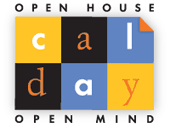
Tours, displays and activities run throughout the day.
All UCMP events take place in the Valley Life Sciences building; locations are noted in the schedule below. Directions to campus and to the building.
UCMP's Cal Day 2011 schedule of events

|
The UC Museum of Paleontology's annual Cal Day open house will be on Saturday, April 16, 2011, between 9:00 am and 4:00 pm. Check out an audio slide show of UCMP's 2009 Cal Day events.
Tours, displays and activities run throughout the day. All UCMP events take place in the Valley Life Sciences building; locations are noted in the schedule below. Directions to campus and to the building. |
| 9:00 | 9:30 | 10:00 | 10:30 | 11:00 | 11:30 | 12:00 | 12:30 | 1:00 | 1:30 | 2:00 | 2:30 | 3:00 | 3:30 |
| MEET T. REX / SCIENCE@CAL: Visit T. rex and Pteranodon, buy a museum t-shirt (new fossil plant design … and T. rex is back!), get your Science@Cal passports stamped, and get free tickets for tours of the UC Museum of Paleontology collections. (Wallace Atrium, 1st floor VLSB) | |||||||||||||
| Climate Change and the Fossil Record: UCMP graduate students and faculty whose studies involve paleoclimates and climate change over time present their research … supported by lots of fossils of course! (1101 VLSB) | Climate Change and the Fossil Record (continued) | ||||||||||||
| Tours of the UCMP Collections: This is your chance to see the museum's extensive collections, normally closed to the public. Tours and tickets are limited. The free tickets, distributed on a first-come, first-served basis at the t-shirt table (near the T. rex), go fast so come early! Tours leave at 9:30, 10:00, 10:30, 11:00, 11:30. (Wallace Atrium, 1st floor VLSB) | Tours of the UCMP Collections (continued) Tours leave at 1:00, 1:30, 2:00, 2:30, 3:00, 3:30. |
||||||||||||
| The Biodiversity Roadshow: Found a leaf, shell, insect, fossil, or vertebrate that needs identifying? Want to know how to preserve these natural items? Experts in botany, entomology, zoology, and paleontology will be on hand. Lots of specimens and live animals too! A Berkeley Natural History Museums collaboration, with support from the Department of Integrative Biology and UC Press. (VLSB courtyard) | |||||||||||||
| Fun With Fossils: Experience the thrill of finding fossils of animals millions of years old in this hands-on activity. You may discover Cretaceous microfossils, gar scales, turtle shell … even dinosaur teeth! (3007 VLSB) | Fun With Fossils (continued) | ||||||||||||
| Lecture:* How to Grow Cranial Appendages: Insights into the Evolution of Antelopes, Deer and Giraffes (2040 VLSB) | ‹ Cattle, antelope, deer, giraffes, and their close relatives almost always have some kind of cranial appendage--horns, antlers, and the like. How similar are these structures? What do we know about how they grow? What did these structures look like in their fossil relatives? What can they tell us about how these animals evolved? We'll take a tour through this fascinating group and the tremendous diversity of their cranial appendages. | ||||||||||||
* Indicates lectures cosponsored by the Department of Integrative Biology.
Visit the official Cal Day site.